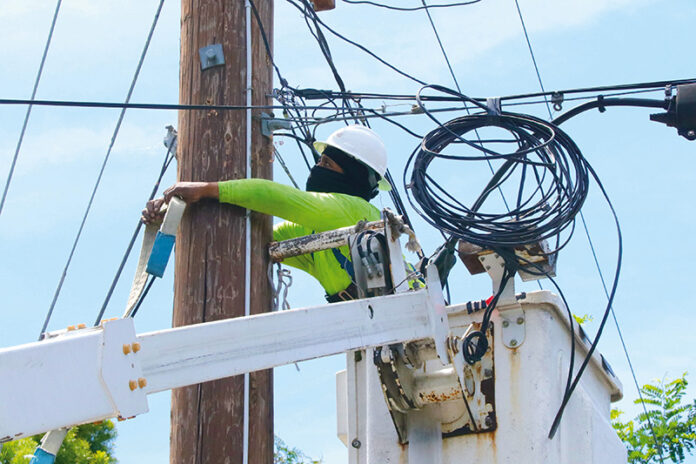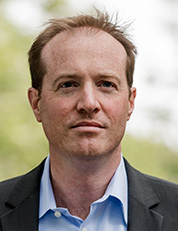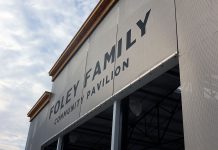
Three white utility trucks spread out through Healdsburg’s residential streets last week, stopping to send a lineman up in the basket for a few-minute adjustment, then speeding off to another utility pole. It was the first physical step in bringing Healdsburg deeper into the 21st century of digital communications—the installation of a fiber-optic network that will deliver internet connectivity over 100 times faster than what most of today’s customers enjoy.
Thank Dane Jasper, and Sonic. Jasper, for almost 10 years a Healdsburg resident (he’s 49, with a wife and three school-aged children), started Sonic with Scott Doty in 1994, dropping out of Santa Rosa Junior College when the business took off (“a classic start-up story,” he said). Though Doty has since retired, Sonic has been on an ever-increasing mission to bring the highest available internet speed to households around the Bay Area, from the dial-up modem of the ’90s to the blazing speed of today’s fiber optic cable.

Much more is expected of an internet connection today than 25 years ago, and if anything the pandemic has increased the need for high-speed connectivity dramatically. Schools assign homework that requires internet connection, business and government meetings are held via video-conferencing, and first-run movies are released in high-definition for streaming delivery. The older connections like DSL (on telephone lines) or coaxial cable simply don’t have the capacity—literally, the bandwidth—to deliver.
“Fundamentally, those copper technologies haven’t been able to keep up just because of the physics of copper,” Jasper recently told the Tribune. Phone wires (which are converted to digital by DSL devices) and especially coaxial cable (Comcast or Xfinity) were designed for download, not upload—broadcast, not communication.
The medium is the difference. Copper is a highly conductive metal, but it is physically incapable of moving data at the speed of light—and that’s how fast the glass-based fiber optic system works. With speeds up to 100 times faster than DSL or cable at their fastest, fiber optic is the best available wire data transfer technology.
Besides schools assigning internet research homework, with people doing their jobs at home, and novices and professionals creating music, video and other shareable media, a fast upload speed is crucial in today’s world. One can also upload one’s own 4K video to YouTube in seconds and conduct a 70-gigabit backup in minutes. And that 10-gigabit speed means one can download a movie in seconds, games in minutes, and stream lossless music flawlessly, without interruption.
“Where we really learned to build out fiber was Sebastopol,” said Jasper. “We had such strong support for Sonic there, so many existing customers, we knew that the investment would make sense.” That was 10 years ago, and Sonic has since become the regional leader in fiber optic, expanding from San Francisco down the peninsula to Santa Clara and into the East Bay. Healdsburg will soon become the fourth Sonoma County town, after Sebastopol, Petaluma and Santa Rosa, to enjoy a fiber optic network.
With their expansion has come surprising, and rewarding, success; they were recently selected by Consumer Reports as the top-rated ISP in the country, and PC Magazine voted them the best community service for gamers, with the lowest latency and among the country’s highest speed.
The citizens of Healdsburg seem ready. When Jasper posted the work schedule for the utility trucks, social media erupted with enthusiastic huzzahs, and many asked if their neighborhoods would be covered.
But unfortunately it’s not going to be for everybody, at least not yet; and ironically it’s the newer neighborhoods that are left out this time. The fiber-optic cables will be installed using the existing overhead utility lines, meaning the streets with telephone poles. Newer developments, notably the 55-plus Rivers Bend communities and Parkland Farms, are lucky enough to have underground utilities, but at this point there’s no way to install a new data delivery system to those areas.
“Those newer areas have underground utilities, and when all those subdivisions were built a conduit was put in by the developer for AT&T, for Comcast and for the electric utility. And that was it. There’s no leftover conduit; it’s sort of designed as a duopoly.” This short-sightedness bothers Jasper, but it does create an opportunity for Sonic.
“Americans pay some of the highest rates for Internet access of all developed nations. That’s a bad outcome of the lack of competitive choice,” continued Jasper. “I think if more communities had a company like Sonic, we wouldn’t have what is effectively a broadband duopoly in most of the country. Really, for speeds over 25 megabits, the majority of households in America have exactly one choice: their local cable company.”
Sonic is also an enthusiastic partner in a federal FCC affordable connectivity program that provides a subsidy adequate to cover the cost of a basic-entry level service, and households that struggle economically can get completely free Internet. As Jasper said, “About 20% of households have no wireless connectivity in the home they rely on. They rely on mobile phones, sometimes subsidized mobile phones, for their connectivity. You can imagine a kid coming home from school trying to do their homework on their parent’s cell phone, and maybe their parent’s not home yet. It’s really not a great idea.”
It’s not only students, but the entire underserved economy that is affected. Once households are connected, said Jasper, “they have access to educational resources and work and job resources and job training resources. That turns out they are able to participate more fully in society. That investment, I think, will end up being a net positive… And so it’s certainly a program we really have supported fully.”
Local connections (no pun intended) eased the way for Sonic’s local expansion. Not only is the Jasper family in local residence, but Sonic has long provided service to the Healdsburg Unified School District and the Healdsburg Hospital. “The City and Sonic already have in place a lease agreement allowing Sonic to attach to Healdsburg’s power poles,” said Utility Director Terry Crowley. “Through the agreement, Healdsburg Electric Department staff reviewed the 800+ new pole attachments, and the City’s Public Works Department reviewed the traffic control and needed repair or replacement of City sidewalks.”
“It’s been a positive process, and we’re excited to see a new option for high speed internet for our residents,” said City Manager Jeff Kay.
Within the next couple months, Sonic will be able to bring fiber optic service to almost half the homes in Healdsburg; the first neighborhoods stand to go online in early August. Even many of Sonic’s long-time customers—and there are many in Healdsburg—who moved to cable for their internet connection over the pandemic are now coming back.
For those who switched internet service providers in the past few years when cable speeds far exceeded DSL, Sonic is offering a sweetener: sign up to pre-order fiber optic service and the company will give credit to offset any early termination fee that local cable company may require. And the first month is free.
The big question: Who can get fiber optic service to their home? The Sonic website has a location search tool at sonic.com/availability that helps homeowners identify their eligibility for it. For those in one of almost 3,000 Healdsburg homes in the serviced area, as little as $30 a month can bring the fastest internet in the country.








